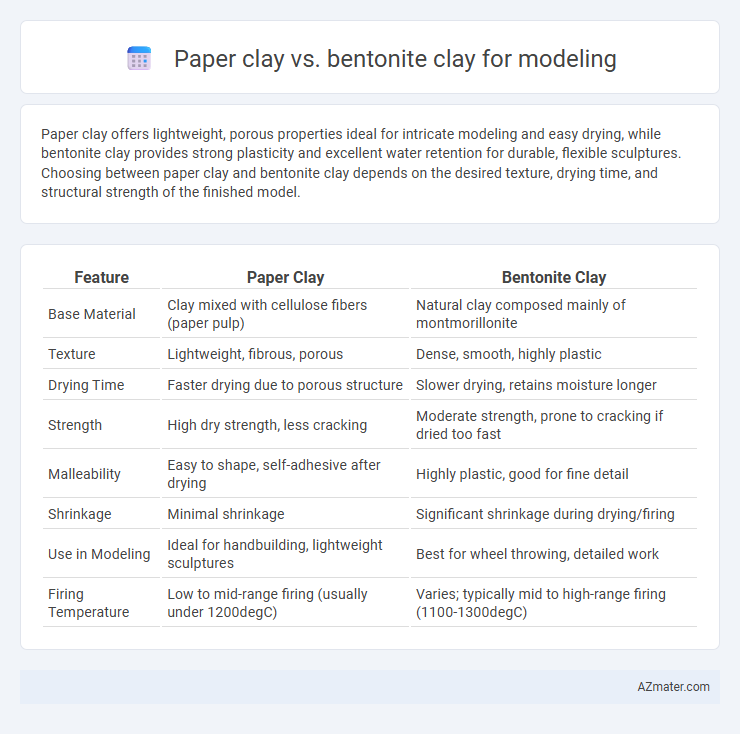Paper clay offers lightweight, porous properties ideal for intricate modeling and easy drying, while bentonite clay provides strong plasticity and excellent water retention for durable, flexible sculptures. Choosing between paper clay and bentonite clay depends on the desired texture, drying time, and structural strength of the finished model.
Table of Comparison
| Feature | Paper Clay | Bentonite Clay |
|---|---|---|
| Base Material | Clay mixed with cellulose fibers (paper pulp) | Natural clay composed mainly of montmorillonite |
| Texture | Lightweight, fibrous, porous | Dense, smooth, highly plastic |
| Drying Time | Faster drying due to porous structure | Slower drying, retains moisture longer |
| Strength | High dry strength, less cracking | Moderate strength, prone to cracking if dried too fast |
| Malleability | Easy to shape, self-adhesive after drying | Highly plastic, good for fine detail |
| Shrinkage | Minimal shrinkage | Significant shrinkage during drying/firing |
| Use in Modeling | Ideal for handbuilding, lightweight sculptures | Best for wheel throwing, detailed work |
| Firing Temperature | Low to mid-range firing (usually under 1200degC) | Varies; typically mid to high-range firing (1100-1300degC) |
Introduction to Modeling Clays
Modeling clays like paper clay and bentonite clay vary significantly in texture and workability, influencing their suitability for different artistic projects. Paper clay combines traditional clay with cellulose fibers, enhancing flexibility and reducing cracking, making it ideal for delicate and lightweight sculptures. Bentonite clay, rich in montmorillonite, offers strong plasticity and excellent binding properties, preferred for detailed modeling requiring durability and moisture retention.
What is Paper Clay?
Paper clay is a lightweight, pliable modeling material composed of natural clay mixed with cellulose fibers, enhancing its strength and flexibility when dry. Unlike bentonite clay, which is dense and purely mineral-based, paper clay allows for easier shaping, repair, and layering, making it ideal for intricate sculpting projects. Its porous texture enables faster drying and less cracking, offering artists greater control and durability in their creations.
What is Bentonite Clay?
Bentonite clay is a highly absorbent, fine-grained clay composed primarily of montmorillonite, known for its swelling properties when mixed with water. It differs from paper clay, which contains paper fibers to enhance strength and flexibility, as bentonite clay is primarily used for its plasticity and binding capabilities in modeling. Artists often choose bentonite clay for its smooth texture and ability to retain moisture, making it ideal for detailed sculpting and forms that require slow drying times.
Key Differences Between Paper Clay and Bentonite Clay
Paper clay is lightweight and infused with cellulose fibers, enhancing its strength and flexibility compared to standard clays, making it ideal for detailed sculpting and air-drying projects. Bentonite clay is a heavy, natural clay composed primarily of montmorillonite, known for its exceptional plasticity and water absorption, which provides excellent moldability but requires kiln firing to harden effectively. The key differences lie in their composition, drying process, and handling qualities: paper clay dries lighter and can be sculpted for fine details without cracking, whereas bentonite clay offers superior molding capabilities but is denser and demands firing for durability.
Workability and Texture Comparison
Paper clay offers superior workability for modeling due to its lightweight composition and added paper fibers, which enhance flexibility and reduce drying cracks. Bentonite clay features a dense, sticky texture with high plasticity, making it ideal for detailed sculpting but prone to longer drying times and potential shrinkage. The fibrous nature of paper clay provides a smoother, more forgiving surface, while bentonite's fine particles deliver a firmer grip and sharper detail retention.
Drying and Firing Characteristics
Paper clay dries faster than bentonite clay due to its fiber content, reducing cracking during drying by distributing stress more evenly. Bentonite clay exhibits superior plasticity but tends to shrink and crack more during drying because of its high water absorption and fine particle size. When fired, paper clay maintains structural integrity at lower temperatures, while bentonite clay requires higher firing temperatures to attain similar strength and vitrification.
Strength and Durability Outcomes
Paper clay offers superior strength and durability compared to Bentonite clay due to its fiber reinforcement from paper pulp, which reduces cracking and increases structural integrity during drying and firing. Bentonite clay, while highly plastic and excellent for detail work, tends to shrink and crack more easily, resulting in less durable finished models. For long-lasting, resilient sculptures, paper clay is preferred for its combination of flexibility and toughness.
Artistic Applications: Paper Clay vs Bentonite Clay
Paper clay offers exceptional flexibility and lightweight properties, making it ideal for detailed sculpting and fine artistic models with easy sanding and painting capabilities. Bentonite clay excels in retaining moisture and plasticity, providing superior workability and smooth surfaces, often favored for wheel throwing and hand-building in ceramics. Artists choose paper clay for delicate textures and mixed media integration, while bentonite clay suits techniques requiring durable, heavy-duty clay consistency and excellent shrinkage control.
Environmental and Safety Considerations
Paper clay offers an eco-friendly alternative to Bentonite clay, as it primarily consists of recycled paper fibers combined with natural clay, reducing waste and energy consumption during production. Bentonite clay, while abundant and natural, can release fine dust particles posing inhalation risks and environmental concerns when mined extensively. Users seeking safer, sustainable modeling materials often prefer paper clay due to its lower dust emission and biodegradable components.
Choosing the Right Clay for Your Modeling Project
Paper clay offers lightweight, flexible properties ideal for detailed modeling and easy sanding after drying, making it suitable for delicate sculptures and mixed-media projects. Bentonite clay, known for its high plasticity and water retention, is best for pottery and projects requiring smooth, cohesive textures and strong moldability. Choosing the right clay depends on project needs--select paper clay for lightweight, fine-detail works and bentonite clay for durable, moisture-rich modeling tasks.

Infographic: Paper clay vs Bentonite clay for Modeling
 azmater.com
azmater.com